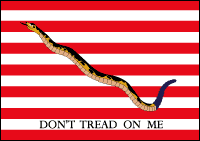 American ships in New England waters flew a "Liberty Tree" flag in 1775. It shows a green pine tree on a white background, with the words, "An Appeal to Heaven."
American ships in New England waters flew a "Liberty Tree" flag in 1775. It shows a green pine tree on a white background, with the words, "An Appeal to Heaven." The Continental Navy used this flag, with the warning, "Don't Tread on Me," upon its inception.
The Continental Navy used this flag, with the warning, "Don't Tread on Me," upon its inception.  The "Betsy Ross" flag. The Flag Resolution did not specify the arrangement of the stars nor the specific proportions of the flag. So many 13-star flags were used, as seen from the next several pictures.
The "Betsy Ross" flag. The Flag Resolution did not specify the arrangement of the stars nor the specific proportions of the flag. So many 13-star flags were used, as seen from the next several pictures.  The Guilford Flag.
The Guilford Flag.  The Serapis Flag.
The Serapis Flag.  At the Battle of Bennington in August 1777 were two famous flags. One, shown here, is called the Bennington Flag or the Fillmore Flag. Nathaniel Fillmore took this flag home from the battlefield. The flag was passed down through generations of Fillmores, including Millard, and today it can be seen at Vermont's Bennington Museum. The other (not pictured) has a green field and a blue canton with 13 gold-painted stars arranged in rows. General John Stark gave his New Hampshire troops a rallying speech that would be the envy of any football coach today. He said, "My men, yonder are the Hessians. They were brought for seven pounds and ten pence a man. Are you worth more? Prove it. Tonight, the American flag floats from yonder hill or Molly Stark sleeps a widow!"
At the Battle of Bennington in August 1777 were two famous flags. One, shown here, is called the Bennington Flag or the Fillmore Flag. Nathaniel Fillmore took this flag home from the battlefield. The flag was passed down through generations of Fillmores, including Millard, and today it can be seen at Vermont's Bennington Museum. The other (not pictured) has a green field and a blue canton with 13 gold-painted stars arranged in rows. General John Stark gave his New Hampshire troops a rallying speech that would be the envy of any football coach today. He said, "My men, yonder are the Hessians. They were brought for seven pounds and ten pence a man. Are you worth more? Prove it. Tonight, the American flag floats from yonder hill or Molly Stark sleeps a widow!"  Cowpens Flag. According to some sources, this flag was first used in 1777. It was used by the Third Maryland Regiment. There was no official pattern for how the stars were to be arranged. The flag was carried at the Battle of Cowpens, which took place on January 17, 1781, in South Carolina. The actual flag from that battle hangs in the Maryland State House.
Cowpens Flag. According to some sources, this flag was first used in 1777. It was used by the Third Maryland Regiment. There was no official pattern for how the stars were to be arranged. The flag was carried at the Battle of Cowpens, which took place on January 17, 1781, in South Carolina. The actual flag from that battle hangs in the Maryland State House.  Vermont and Kentucky joined the union in 1791 and 1792. This flag with 15 stars and 15 stripes, was adopted by a Congressional act of 1794. The flag became effective May 1, 1795.
Vermont and Kentucky joined the union in 1791 and 1792. This flag with 15 stars and 15 stripes, was adopted by a Congressional act of 1794. The flag became effective May 1, 1795.  By 1818, the union consisted of 20 states. A Congressional act mandated that the number of stripes be fixed at 13 and that one new star was to be added for each new state, the July 4 following its admission. However, nothing was written about what arrangement the stars should be in. This and the following two flags were all used simultaneously.
By 1818, the union consisted of 20 states. A Congressional act mandated that the number of stripes be fixed at 13 and that one new star was to be added for each new state, the July 4 following its admission. However, nothing was written about what arrangement the stars should be in. This and the following two flags were all used simultaneously.  Another 1818 flag (see above).
Another 1818 flag (see above).
 And another 1818 flag (see above). This was called the "Grand Star" flag.
And another 1818 flag (see above). This was called the "Grand Star" flag.
To see examples of later flags, see our Flag Timeline
Starting in 1819, the updated flag becomes legal on the Fourth of July following the date of admission September 11, 2001 — The Flag from the World Trade towers survives and becomes a symbol of sacrifice in service, loss, and determination
September 11, 2001 — The Flag from the World Trade towers survives and becomes a symbol of sacrifice in service, loss, and determination The United States flag today. The 50th star was added on July 4, 1960 for Hawaii, which entered the Union on August 21, 1959
The United States flag today. The 50th star was added on July 4, 1960 for Hawaii, which entered the Union on August 21, 1959
This material is copyright by, and used with permission of, the Independence Hall Association, on the web at ushistory.org.
Tuesday, July 3, 2007
Stars and Stripes and the 4th of July - a history of the American Flag in pictures
Posted by
Grandmother Wren
at
12:57 PM
![]()
Labels: 4th of July, summer, United States Flag
